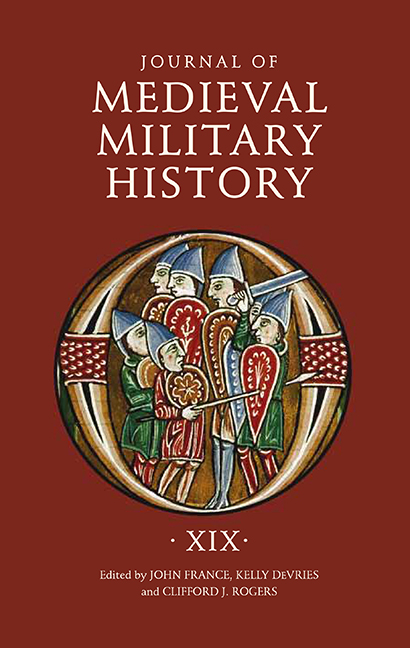Book contents
- Frontmatter
- Contents
- List of Illustrations
- 1 The Battle of Firāḍ: The Day on Which Khālid b. al-Walīd Did [Not] Defeat Both Byzantines and Persians
- 2 A Mislocated Battlefield? Battle Flats: The Battle of Stamford Bridge, 1066
- 3 The Frankish Campaign of 1133–1134 in Northern Syria and the Battle of Qinnasrīn
- 4 Bella Plus Quam Civilia? The Place of Battle in the Context of Civil War under the Anglo-Norman and Angevin Kings, c. 1100–c. 1217
- 5 Edward I’s War on the Continent, 1297–1298: A New Appraisal
- 6 The Earliest European Recipes for “Powder for Guns” (1336 and 1338–c. 1350)
- 7 Bellicose Rhetoric: The Memorable War Speeches of One Aragonese Royal Couple
- 8 Coureurs and Their Role in Late Medieval Warfare
- List of Contributors
- Journal of Medieval Military History 1477–545X
3 - The Frankish Campaign of 1133–1134 in Northern Syria and the Battle of Qinnasrīn
Published online by Cambridge University Press: 02 June 2021
- Frontmatter
- Contents
- List of Illustrations
- 1 The Battle of Firāḍ: The Day on Which Khālid b. al-Walīd Did [Not] Defeat Both Byzantines and Persians
- 2 A Mislocated Battlefield? Battle Flats: The Battle of Stamford Bridge, 1066
- 3 The Frankish Campaign of 1133–1134 in Northern Syria and the Battle of Qinnasrīn
- 4 Bella Plus Quam Civilia? The Place of Battle in the Context of Civil War under the Anglo-Norman and Angevin Kings, c. 1100–c. 1217
- 5 Edward I’s War on the Continent, 1297–1298: A New Appraisal
- 6 The Earliest European Recipes for “Powder for Guns” (1336 and 1338–c. 1350)
- 7 Bellicose Rhetoric: The Memorable War Speeches of One Aragonese Royal Couple
- 8 Coureurs and Their Role in Late Medieval Warfare
- List of Contributors
- Journal of Medieval Military History 1477–545X
Summary
During the first half of the 1130s, King Fulk of Jerusalem led his troops to northern Syria at least three times. In one of these campaigns, he met the Turkmen and the Aleppan troops and defeated them in the battle of Qinnasrīn, 25 km southwest of Aleppo. Since primary sources give a variety of dates for the battle, scholars describe it as taking place at various points in time between Safar 527/December 1132 and Rabī’ I 528/January 1134. Based on Latin, Muslim, and Syriac chronicles, this article aims to resolve the problem of dating the battle of Qinnasrīn.
The early 1130s were turbulent times for Frankish Syria. In 1128, Atābek ‘Imād al-Dīn Zankī, ruler of Mosul, established his authority over Aleppo, thereby threatening the Principality of Antioch and the County of Edessa. Zankī's power and influence were growing and, although he had still not become the leader of jihad, there was no doubt that the Franks in Syria and Palestine faced a new dangerous enemy who was able to unite a great part of the Muslim world against them.
The rise of Zankī coincided with the deaths of Prince Bohemond II of Antioch (1126–1130), who was killed during fighting in Cilicia; King Baldwin II of Jerusalem (1118–1131); and Count Joscelyn I of Edessa (1119–1131). The Count of Edessa's son and successor, Joscelyn II (1131–1150), was relatively successful in fighting against Sawār, Zankī's governor in Aleppo. The death of Bohemund II, however, had dire consequences for the Principality of Antioch. During the period of interregnum, the principality lost the Cilician plain with the cities of Mamistra, Tarsus and Adana, seized by Prince Levon I Rubenid in 1132, and the important fortresses on the eastern borders of the principality (al-Atharib, Zardana, Tell Aghda, Ma’arrat an-Nu’man, Kafartab), captured by Zankī in 1135. Levon Rubenid also captured the castle of Servantikar in the same year.
There had thus been a change of ruler almost simultaneously in three of four Crusader states of the East, and this had clear implications for relations among them. After Prince Bohemond II's death in battle in 1130 and until Raymond of Poitiers’ arrival in the East in 1136, the Principality of Antioch had no ruler and was under the military protection of the king of Jerusalem, although the king's influence on its policy was diminishing in comparison with the previous period.
- Type
- Chapter
- Information
- Journal of Medieval Military HistoryVolume XIX, pp. 43 - 56Publisher: Boydell & BrewerPrint publication year: 2021



